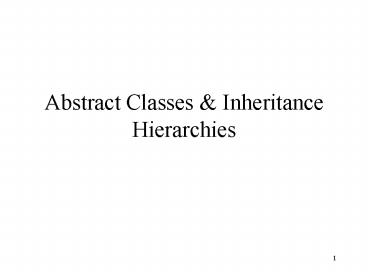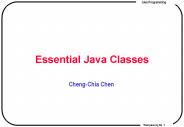Abstract Classes - PowerPoint PPT Presentation
Title:
Abstract Classes
Description:
Keyword abstract applied to a class guarantees that subclass must be constructed ... made up of other objects -- e.g. a blender has a motor, a set of controls, and a ... – PowerPoint PPT presentation
Number of Views:51
Avg rating:3.0/5.0
Title: Abstract Classes
1
Abstract Classes Inheritance Hierarchies
2
Abstract classes methods
- Keyword abstract applied to a class guarantees
that subclass must be constructed - Individual methods in an abstract class can be
declared abstract such methods must be
overridden by child classes - Abstract classes almost always contain abstract
methods, but not all methods have to be abstract
3
Abstract classes methods
- Abstract methods are like interface methods
specified but undefined - Abstract classes are used to factor out common
behavior from sets of related (sub)classes - Abstract classes cannot be instantiated but, as
with interfaces, can declare variables of
abstract class type
4
Abstract classes
- Abstract classes are created strictly as
superclasses - Can have instance fields and methods
- Can tag any class as abstract means cant create
objects from this class, but can inherit from it
5
Abstract classes Vs. interfaces
- Advantage of abstract class is ability to define
some behavior as well as specify it more can be
inherited from an abstract class than from an
interface - Disadvantage is lack of multiple inheritance can
only inherit from one class, but can implement as
many interfaces as desired
6
Abstract classes Vs. interfaces
- Abstract classes can have fields
- Interface types can only have constants (public
static final) - Abstract classes can define methods
- Interface types can only declare methods
7
Abstract classes interfaces
- Good idea to supply both an interface type and a
class that implements some of its methods with
convenient defaults gives best of both worlds - Java library has many examples of such pairs
8
Modifiers and Inheritance
- Public data field or method can be accessed
outside its class definition a public class can
be accessed outside its package - Protected data field or method can be accessed
within its class, within other classes in its
package, or within subclasses - Private data field or method can be accessed only
within its class
9
Modifiers and Inheritance
- Static fields are shared by all instances of a
class can be invoked even is no class instance
has been created static methods cannot be
overridden - Abstract classes cannot be instantiated, and can
only be used as parent classes
10
Modifiers and Inheritance
- Modifier final is opposite of abstract
- when applied to a class, means the class cannot
be subclassed - when applied to a method, means method cannot be
overridden - when applied to a variable, the variable becomes
a constant
11
Benefits of Inheritance
- Software reusability
- code sharing
- reusable components
- Increased reliability code that is executed
frequently tends to have fewer bugs - Interface consistency
- Information hiding
12
Costs of Inheritance
- Execution speed - inherited methods often slower
than code written for specific purpose - Program size
- Message-passing overhead
- Program complexity
13
Inheritance Vs. Composition
- Both are techniques for software reuse
- Inheritance is appropriate in a situation when
one object is a specialized type of another
object -- e.g. a professor is a teacher - Composition is appropriate when an object is made
up of other objects -- e.g. a blender has a
motor, a set of controls, and a container to hold
the contents
14
Hierarchy of Swing Components
- Java libraries contain several examples of
hierarchical classes related by inheritance - User interface component classes in the swing
library present one such example
15
Components
- Base of the component hierarchy is the Component
class includes methods - getWidth(), getHeight(), setSize(int,int)
- setBackground(Color c), getBackground()
- setVisible(boolean), setEnabled(boolean)
- repaint(Graphics), paint(Graphics)
- setFont(Font), getFont()
- addMouseListener(MouseListener),
addKeyListener(KeyListener)
16
Containers
- Container class is subclass of Component most
important property is its ability to contain
components - Methods include
- setLayout(LayoutManager)
- add(Component), remove(Component)
17
A little history ...
- First came AWT, Abstract Window Toolkit
- Used native components, resulting in subtle
platform inconsistencies - Write once, run anywhere -gt Write once, debug
everywhere - Swing library developed as platform-independent
solution
18
Characteristics of Swing
- All components painted on blank windows
- all components drawn pixel by pixel
- when component changes state (e.g. button
pushed), toolkit redraws it - Swing has complete control over behavior of
components - does not use native components
19
Hierarchy of Swing Components
20
Hierarchy of standard geometric shapes
- Original AWT classes integer coordinates
- Point
- Rectangle
- Polygon
- Java 2 introduced java.awt.geom package - more
sophisticated shapes with floating-point
coordinates - Legacy classes are folded into new hierarchy
21
Hierarchy of standard geometric shapes
22
RectangularShape
- Superclass for Rectangle2D, RoundRectangle2D,
Ellipse2D and Arc2D - Methods include
- getCenterX, getCenterY
- getMinX, getMinY, getMaxX, getMaxY
- getWidth, getHeight
- setFrameFromCenter, setFrameFromDiagonal
23
Rectangle2D class
- Has inner classes Float and Double hence the
name Rectangle2D.Double - Rectangle2D is an abstract class inner classes
Float and Double are concrete subclasses that
define a small number of methods, including
getX(), getY(), getWidth() and getHeight()
24
Template Method design pattern
- Superclass defines a method that calls primitive
operations that a subclass needs to supply - Each subclass can supply the primitive operations
most appropriate for it - Template method contains knowledge of how to
combine primitive operations into more complex
operation
25
Template method pattern context
- An algorithm is applicable for multiple types
- The algorithm can be broken down into primitive
operations - The primitive operations can be different for
each type - The order of the primitive operations doesn't
depend on the type
26
Template method pattern solution
- Define a superclass that has a method for the
algorithm and abstract methods for the primitive
operations. - Implement the algorithm to call the primitive
operations in the appropriate order.
27
Template method pattern solution
- Do not define the primitive operations in the
superclass, or define them to have appropriate
default behavior. - Each subclass defines the primitive operations
but not the algorithm.
28
Template Method Pattern
29
Rectangle2D and the Template Method Pattern
- Most of the work is done by Rectangle2D methods,
not inner classes parent class methods call
inner class (primitive) methods as needed - Example
- public boolean contains(double x, double y)
double x0 getX() double y0 getY()
return x gt x0 y gt y0 x lt x0 getWidth()
y lt y0 getHeight()
30
Template Method pattern Rectangle2D
- Pattern name
- AbstractClass
- ConcreteClass
- templateMethod
- primitiveOpn
- Actual name
- Rectangle2D
- Rectangle2D.Double
- contains()
- getX(), getY(), etc.
31
Hierarchy of Exception Classes
- All exceptions extend class Throwable
- Throwable has two subclasses
- Error subclasses of this denote fatal errors
(e.g. divide by 0, out of memory, etc.) - Exception superclass for all exceptions that
occur on an application level
32
Exception class
- Has several subclasses notable among these is
RuntimeException - superclass for all unchecked exceptions
- examples include NullPointerException and
IndexOutOfBoundsException - All subclasses of Exception that are not
subclasses of RuntimeException are checked
exceptions
33
Checked Exceptions
- These are the type of exceptions that require
either a throws clause or try/catch block - Example IOException and its subclasses
34
Hierarchy of Exception Classes
35
Defining Exception Classes
- Decide whether or not exception should be checked
- Use checked exception if error condition is out
of programmer control (e.g. a network failure) - Use unchecked exception if error caused by
programmer inattention (e.g. null pointer
exception) - Subclass Exception or RuntimeException - note
that unchecked exceptions must subclass
RuntimeException
36
Defining Exception Classes
- Provide two constructors
- public class IllegalFormatException extends
Exception public IllegalFormatException()
public IllegalFormatException(String
reason) super(reason) - Throw exception when needed
- throw new IllegalFormatException("number
expected")































